Exchange Currency
Nigerian naira
The naira is the currency of Nigeria. It is subdivided into 100 kobo.
The Central Bank of Nigeria (CBN) is the sole issuer of legal tender money throughout the Federation. It controls the volume of money supply in the economy in order to ensure monetary and price stability. The Currency & Branch Operations Department of the CBN is in charge of currency management, through the procurement, distribution/supply, processing, reissue and disposal/disintegration of banknotes and coins.
On 1st July, 1959 the Central Bank of Nigeria issued the Nigerian currency notes and coins and the West African Currency Board notes and coins were withdrawn. It was not until 1st July, 1962 that legal tender status was changed to reflect the country’s new status. The notes were again changed in 1968 as a war strategy following the misuse of the country’s currency notes.
On 31st March, 1971, the then Head of State announced that Nigeria would change to decimal currency as from 1st January, 1973.The major currency unit would be called Naira which would be equivalent to ten shillings: the minor unit would be called kobo; 100 of which would make one Naira. The decision to change to decimal currency followed the recommendations of the Decimal Currency Committee set up in 1962 which submitted its report in 1964.
The change that took place in January, 1973 was a major one and this involved both currency notes and coins. The major unit of currency which used to be £1 ceased to exist and the one Naira which was equivalent to 10/- become the major unit.
On 11th February, 1977 a new banknote denomination of the value of 20 Naira was issued. This was special in two respects:
The N20(Twenty Naira) banknote was the highest denomination to be introduced then, and its issue became necessary as a result of the growth of incomes in the country; the preference for cash transactions and the need for convenience.
The N20 (Twenty Naira) banknote became the first currency note in Nigeria bearing the Portrait of a Nigerian citizen, in this case, the late Head of State, General Murtala Ramat Muhammed (1938-1976) who was the torchbearer of the Nigerian Revolution July, 1975.
He was declared a national hero on the 1st of October,1978. The note was issued on the 1st Anniversary of his assassination as a fitting tribute to a most illustrious son of Nigeria. On 2nd July, 1979, new currency notes of three denominations, namely, ( N1), (N5), and (N10) were introduced. These notes were of the same size i.e., 151 x 78 mm as the N20 note issued on the 11th February, 1977. In order to facilitate identification, distinctive colors which were similar to those of the current banknotes of the various denominations were used. The notes bore the portraits of three eminent Nigerians who were declared national heroes on the 1st of October, 1978. The engravings at the back of the notes reflected the cultural aspects of the country. In 1991, both the 50k and N1 Notes were coined. In response to expansion in economic activities and to facilitate an efficient payments system, the N100, N200, N500, N1000 were introduced in December 1999, November 2000, April 2001 and October, 2005 respectively.
On 28 February 2007, new coins were issued in denominations of 50 kobo, 1 and 2 naira, with the 1 and 2 naira bimetallic. Some Nigerians expressed concerns over the usability of the N2 coin. The deadline for exchanging the old currency was set at 31 May 2007. The central bank stated that the ½ to 25 kobo coins were withdrawn from circulation with effect from 28 February 2007.
On February 28, 2007, new versions of the 5 to 50 naira banknotes were introduced. Originally the 10, 20 and 50 naira were to be polymer banknotes, but the 5,10 and 50 were delayed to late 2009 and only the 20 was released in polymer. The notes are slightly smaller (130 x 23 mm) and redesigned from the preceding issues. In mid 2009 when Sanusi Lamido Sanusi took over as CBN Governor he eventually changed the 5, 10 and 50 naira to polymer notes.
On the 1000 naira notes, there is a subtle shiny strip running down the back of the note. It is a shimmery gold colour showing 1000 naira. The triangular shape in the middle of the front of the note changes its colour from green to blue when tilted. The main feature on the front is the engraved portraits of Alhaji Aliyu Mai-Bornu and Dr Clement Isong, former governors of the Central Bank of Nigeria.
On the first prints of the 100 naira notes issued starting December 1, 1999, Zuma Rock was captioned as located in Federal Capital Territory, while actually it is situated in Niger State. Later prints removed the reference to FCT, ABUJA.
The naira was scheduled for redenomination in August 2008, although this was cancelled by then-President Umaru Musa Yar'Adua), with 100 old naira to become 1 new naira. The Nigerian Central Bank stated that it will make the naira fully convertible against foreign currencies by 2009. Currently, the amount of foreign currency is regulated through weekly auctions, while the Central Bank sets the exchange rate. The naira appreciated against the dollar through 2007 due to high oil revenues. Also, the then-Bank Governor, Professor Chukwuma Soludo noted the weekly central bank auctions of foreign currency will gradually be phased out, and that the bank would "only intervene in the market as may be required to achieve defined policy objectives".
Summary info
Summary information about Nigerian naira- ISO 4217 Code:
- NGN
- Currency sign:
- ₦
- Country:
- Nigeria
- Subunit:
- kobo
- Coins:
- ½ kobo, 1 kobo, 5 kobo, 10 kobo, 25 kobo, 50 kobo, 1 naira, 2 naira
- Banknotes:
- 5 naira, 10 naira, 20 naira, 50 naira, 100 naira, 200 naira, 500 naira, 1000 naira
- Central bank:
- Central Bank of Nigeria
History
The West African Currency Board was responsible for issuing currency notes in Nigeria from 1912 to 1959. Prior to the establishment of the West African Currency Board, Nigeria had used various forms of money including cowries and manilas.On 1st July, 1959 the Central Bank of Nigeria issued the Nigerian currency notes and coins and the West African Currency Board notes and coins were withdrawn. It was not until 1st July, 1962 that legal tender status was changed to reflect the country’s new status. The notes were again changed in 1968 as a war strategy following the misuse of the country’s currency notes.
On 31st March, 1971, the then Head of State announced that Nigeria would change to decimal currency as from 1st January, 1973.The major currency unit would be called Naira which would be equivalent to ten shillings: the minor unit would be called kobo; 100 of which would make one Naira. The decision to change to decimal currency followed the recommendations of the Decimal Currency Committee set up in 1962 which submitted its report in 1964.
The change that took place in January, 1973 was a major one and this involved both currency notes and coins. The major unit of currency which used to be £1 ceased to exist and the one Naira which was equivalent to 10/- become the major unit.
On 11th February, 1977 a new banknote denomination of the value of 20 Naira was issued. This was special in two respects:
The N20(Twenty Naira) banknote was the highest denomination to be introduced then, and its issue became necessary as a result of the growth of incomes in the country; the preference for cash transactions and the need for convenience.
The N20 (Twenty Naira) banknote became the first currency note in Nigeria bearing the Portrait of a Nigerian citizen, in this case, the late Head of State, General Murtala Ramat Muhammed (1938-1976) who was the torchbearer of the Nigerian Revolution July, 1975.
He was declared a national hero on the 1st of October,1978. The note was issued on the 1st Anniversary of his assassination as a fitting tribute to a most illustrious son of Nigeria. On 2nd July, 1979, new currency notes of three denominations, namely, ( N1), (N5), and (N10) were introduced. These notes were of the same size i.e., 151 x 78 mm as the N20 note issued on the 11th February, 1977. In order to facilitate identification, distinctive colors which were similar to those of the current banknotes of the various denominations were used. The notes bore the portraits of three eminent Nigerians who were declared national heroes on the 1st of October, 1978. The engravings at the back of the notes reflected the cultural aspects of the country. In 1991, both the 50k and N1 Notes were coined. In response to expansion in economic activities and to facilitate an efficient payments system, the N100, N200, N500, N1000 were introduced in December 1999, November 2000, April 2001 and October, 2005 respectively.
Coins
In 1973, coins were introduced in denominations of ½, 1, 5, 10 and 25 kobo, with the ½ and 1 kobo in bronze and the higher denominations in cupro-nickel. The ½ kobo coins were only minted that year. In 1991, smaller 1, 10 and 25 kobo coins were issued in copper-plated-steel, along with nickel-plated-steel 50 kobo and 1 naira.On 28 February 2007, new coins were issued in denominations of 50 kobo, 1 and 2 naira, with the 1 and 2 naira bimetallic. Some Nigerians expressed concerns over the usability of the N2 coin. The deadline for exchanging the old currency was set at 31 May 2007. The central bank stated that the ½ to 25 kobo coins were withdrawn from circulation with effect from 28 February 2007.
Banknotes
On January 1, 1973, the Central Bank of Nigeria introduced notes for 50 kobo, 1, 5, 10 and 20 naira. The 50 kobo notes were last issued in 1989. In 1991, 50 naira notes were issued, followed by 100 naira in 1999, 200 naira in 2000, 500 naira in 2001 and 1000 naira on October 12, 2005.On February 28, 2007, new versions of the 5 to 50 naira banknotes were introduced. Originally the 10, 20 and 50 naira were to be polymer banknotes, but the 5,10 and 50 were delayed to late 2009 and only the 20 was released in polymer. The notes are slightly smaller (130 x 23 mm) and redesigned from the preceding issues. In mid 2009 when Sanusi Lamido Sanusi took over as CBN Governor he eventually changed the 5, 10 and 50 naira to polymer notes.
On the 1000 naira notes, there is a subtle shiny strip running down the back of the note. It is a shimmery gold colour showing 1000 naira. The triangular shape in the middle of the front of the note changes its colour from green to blue when tilted. The main feature on the front is the engraved portraits of Alhaji Aliyu Mai-Bornu and Dr Clement Isong, former governors of the Central Bank of Nigeria.
On the first prints of the 100 naira notes issued starting December 1, 1999, Zuma Rock was captioned as located in Federal Capital Territory, while actually it is situated in Niger State. Later prints removed the reference to FCT, ABUJA.
The naira was scheduled for redenomination in August 2008, although this was cancelled by then-President Umaru Musa Yar'Adua), with 100 old naira to become 1 new naira. The Nigerian Central Bank stated that it will make the naira fully convertible against foreign currencies by 2009. Currently, the amount of foreign currency is regulated through weekly auctions, while the Central Bank sets the exchange rate. The naira appreciated against the dollar through 2007 due to high oil revenues. Also, the then-Bank Governor, Professor Chukwuma Soludo noted the weekly central bank auctions of foreign currency will gradually be phased out, and that the bank would "only intervene in the market as may be required to achieve defined policy objectives".
NGN banknotes pictures gallery
| 5 Nigerian naira | |
|---|---|
| Banknote of 5 Nigerian naira has dimensions 130×72 mm and main colors are pale chestnut, khaki, tea rose, tumbleweed, grullo, taupe gray and rosy brown. The banknote of the 5 Nigerian naira was issued for the first time in 2006. | |
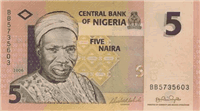 Obverse side of the 5 Nigerian naira is showing portrait of Alhaji Sir Abubakar Tafawa Balewa (1912-1966), educationist, and the first Prime Minister from September 1957 to January 1966. |
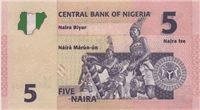 Reverse side of the 5 Nigerian naira is showing the Nkpokiti Dancers from the South Eastern part of Nigeria. |
| 10 Nigerian naira | |
|---|---|
| Banknote of 10 Nigerian naira has dimensions 130×72 mm and main colors are apricot, peach-yellow, tuscan red, rose vale, fawn and desert sand. The banknote of the 10 Nigerian naira was issued for the first time in 2006. | |
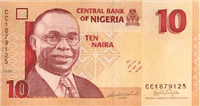 Obverse side of the 10 Nigerian naira is showing the portrait of Dr. Alvan Ikoku (1900-1971), a prominent educationist. |
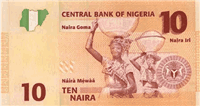 Reverse side of the 10 Nigerian naira is showing a picture of Fulani milkmaids. |
| 20 Nigerian naira | |
|---|---|
| Banknote of 20 Nigerian naira has dimensions 130×72 mm and main colors are grullo, dark sea green, cambridge blue, platinum, feldgrau and gainsboro. The banknote of the 20 Nigerian naira was issued for the first time in 2006. | |
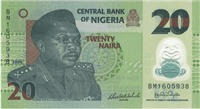 Obverse side of the 20 Nigerian naira is showing the portrait of a national hero in the person of the late Head of State - General Murtala Mohammed (1938-1976). |
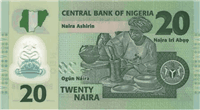 Reverse side of the 20 Nigerian naira is showing the portrait of Ladi Kwali, a famous potter. |
| 50 Nigerian naira | |
|---|---|
| Banknote of 50 Nigerian naira has dimensions 130×72 mm and main colors are pastel blue, aurometalsaurus, dark electric blue, lavender gray and manatee. The banknote of the 50 Nigerian naira was issued for the first time in 2006. | |
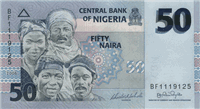 Obverse side of the 50 Nigerian naira is showing the Nigerians, two men Hausa and Igbo and a woman - Yoruba. |
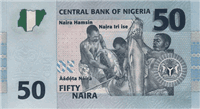 Reverse side of the 50 Nigerian naira is showing a big catch by local fishermen. |
| 100 Nigerian naira | |
|---|---|
| Banknote of 100 Nigerian naira has dimensions 151×78 mm and main colors are rosy brown, cinereous, desert sand, pastel blue, pale chestnut and isabelline. The banknote of the 100 Nigerian naira was issued for the first time in 1999. | |
 Obverse side of the 100 Nigerian naira is showing the portrait of Chief Obafemi Awolowo, former Premier of Western Region. |
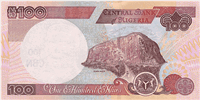 Reverse side of the 100 Nigerian naira is showing the picture of the Zuma Rock - a major landmark in Niger State in the Northern part of the Federation close the Federal Capital. |
| 200 Nigerian naira | |
|---|---|
| Banknote of 200 Nigerian naira has dimensions 151×78 mm and main colors are cadet grey, pastel brown, trolley grey, mauvelous, pearl and desert sand. The banknote of the 200 Nigerian naira was issued for the first time in 2000. | |
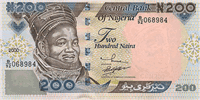 Obverse side of the 200 Nigerian naira is showing the picture of Alhaji Sir Ahmadu Bello, - the Sardauna of Sokoto and the first Premier of Northern Nigeria. |
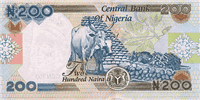 Reverse side of the 200 Nigerian naira is showing a pyramid of agricultural commodity and livestock farming. |
| 500 Nigerian naira | |
|---|---|
| Banknote of 500 Nigerian naira has dimensions 151×78 mm and main colors are dark gray, rose quartz, banana mania, wheat, pearl, anti-flash white and pale chestnut. The banknote of the 500 Nigerian naira was issued for the first time in 2001. | |
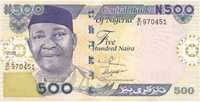 Obverse side of the 500 Nigerian naira is showing the portrait of Dr. Nnamdi Azikiwe - first President of the Federal Republic of Nigeria. |
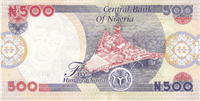 Reverse side of the 500 Nigerian naira is showing the picture of an off-shore oil-rig. |
| 1000 Nigerian naira | |
|---|---|
| Banknote of 1000 Nigerian naira has dimensions 151×78 mm and main colors are bistre, pale taupe, desert sand, lavender gray, tan and misty rose. The banknote of the 1000 Nigerian naira was issued for the first time in 2005. | |
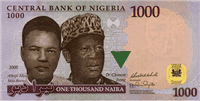 Obverse side of the 1000 Nigerian naira is showing the portraits of Alhaji Aliyu Mai Bornu and Dr. Clement Isong - who were the first and second indigenous Governors of the Central Bank of Nigeria. |
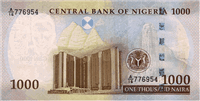 Reverse side of the 1000 Nigerian naira is showing the picture of CBN's corporate Head Office in Abuja, Federal Capital Territory of Nigeria. |
Useful links
- About Central Bank of Nigeria:
- Central Bank of Nigeria
- List of currencies:
- Currencies
- Security and design features of NGN banknotes:
- NGN banknotes
- NGN currency on Wikipedia:
- Nigerian naira
- Official Website of Central Bank of Nigeria:
- www.cenbank.org
- Commemorative coins:
- Commemorative Coins